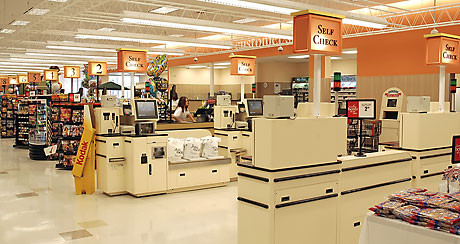SHARE:
Retail
The Art of the Aisle
A walk through Florida's grocery stores shows how the chains use design to sell to consumers who are demanding more of everything.
Center Store
The center store portion of a grocery has traditionally been where items like paper products, canned goods, pet food and cleaning supplies are stocked. While this section typically generates about 50% of a store’s sales, consumers are buying more of those traditional center store products at super centers, warehouse clubs and other venues. As a result, the center store has acquired a reputation as the supermarket’s “dead zone” and is actually shrinking, says Ohlinger, as stores move items to the periphery to try to boost sales. The Fresh Market, a boutique grocer with stores in 20 Florida locations, eschews the traditional center store strategy altogether. Its center section is dominated by a large deli. A limited selection of groceries is located in five aisles in the back left of the store that are angled to funnel customers back toward the perishables sections along the perimeter and in the middle.
Traditional grocers are employing new techniques to break up the monotony of the 80-foot-long aisle: Sweetbay has introduced black convex shelves that bow out to display products like marinades, oils and spices. Publix has blocked out “GreenWise” areas in its center aisles to highlight its line of organic products.
The Front End
Aside from an increased number of displays near the cash registers, offering sodas and cold bottled water along with gum and batteries, the biggest change at the checkout aisle is the slow emergence of self-scanning technology. At an Albertson’s store in Clearwater, four customers scan their groceries while a single clerk at a centrally located register keeps an eye on the process. Sweetbay is testing the technology at two locations. While relatively few Florida supermarket chains are using the self-checkout technology now, Ohlinger expects more food retailers will adopt it. The do-it-yourself technology answers the consumer demand for a speedy checkout while reducing labor costs. Self-checkout terminals cost about $92,000 upfront but only $15,000 a year to maintain — or about 58 cents per hour at a store that is open 24 hours a day.
Contrary to the assumption that the self-checkouts would primarily appeal to the customer who wants to get in and out quickly, Sweetbay discovered that the self-checkouts are most popular among elderly clientele who don’t want to be rushed through the checkout.
One big drawback for grocers: Self-checkout reduces impulse buys. The IHL Consulting Group found a 43% drop in sales of candy, gum and breath mints, a 53% drop in sales of chips and salty snacks and 50% decline in soda and water at self-checkouts.
 DO-IT-YOURSELF: Self-checkout aisles like this one at Winn-Dixie are catching on slowly. One drawback: They reduce impulse buys of items like candy and gum. [Photo courtesy Winn-Dixie ] |




















 Business Beat - Week of May 3rd
Business Beat - Week of May 3rd


